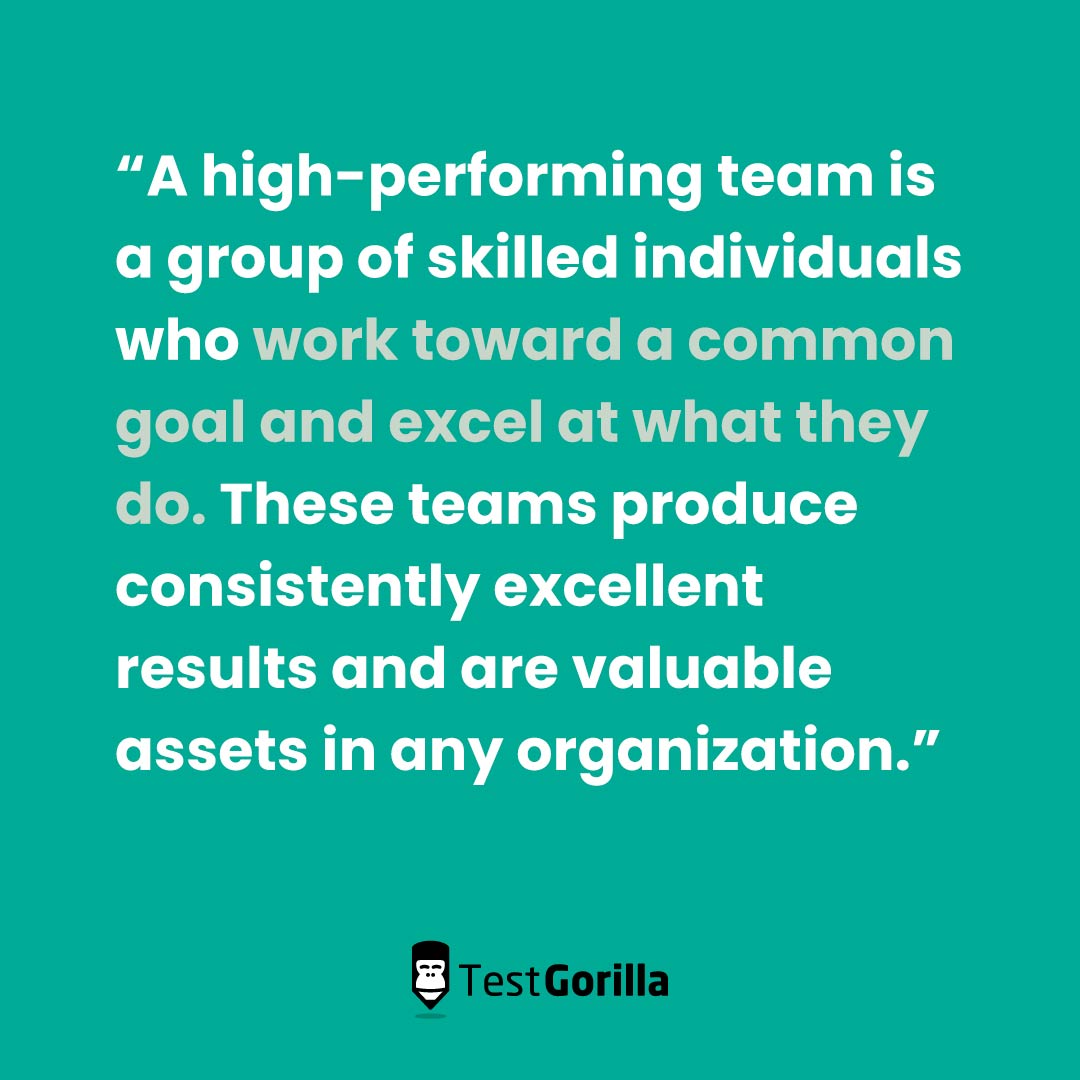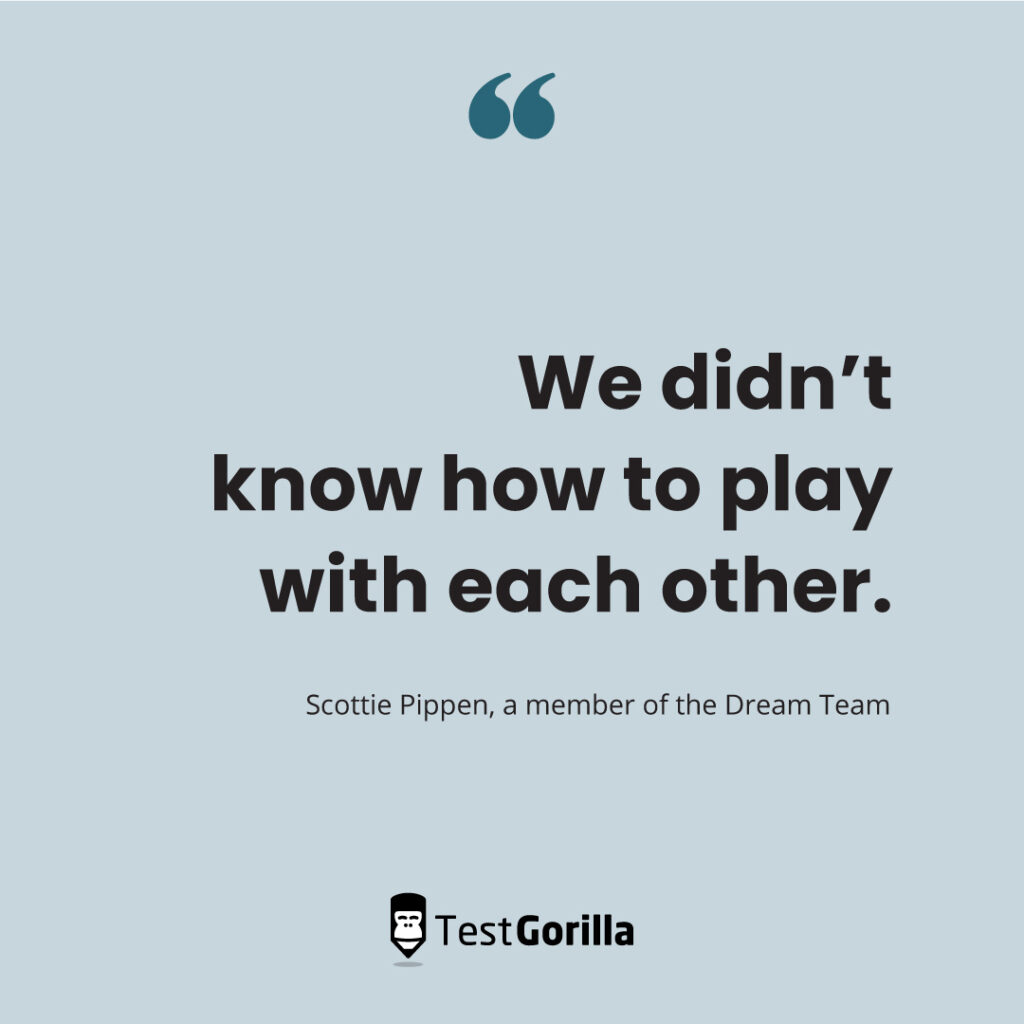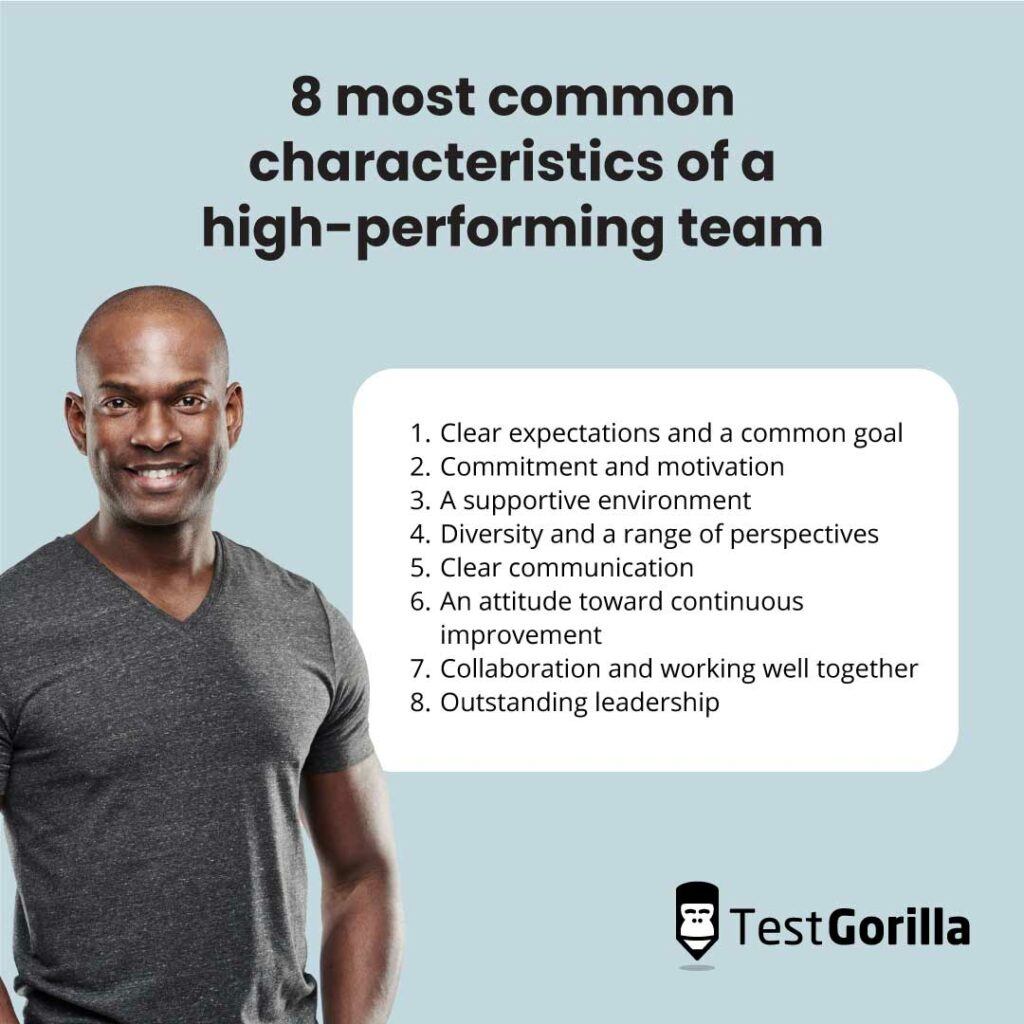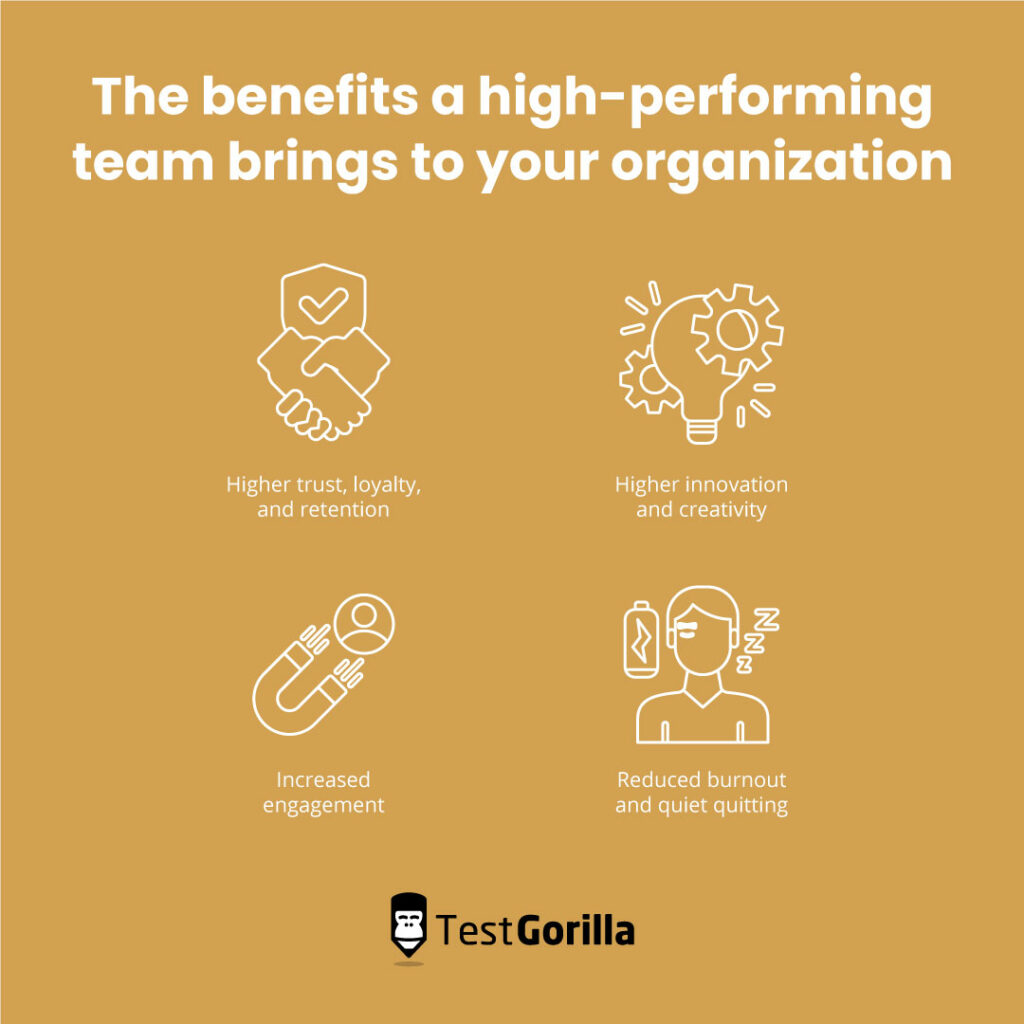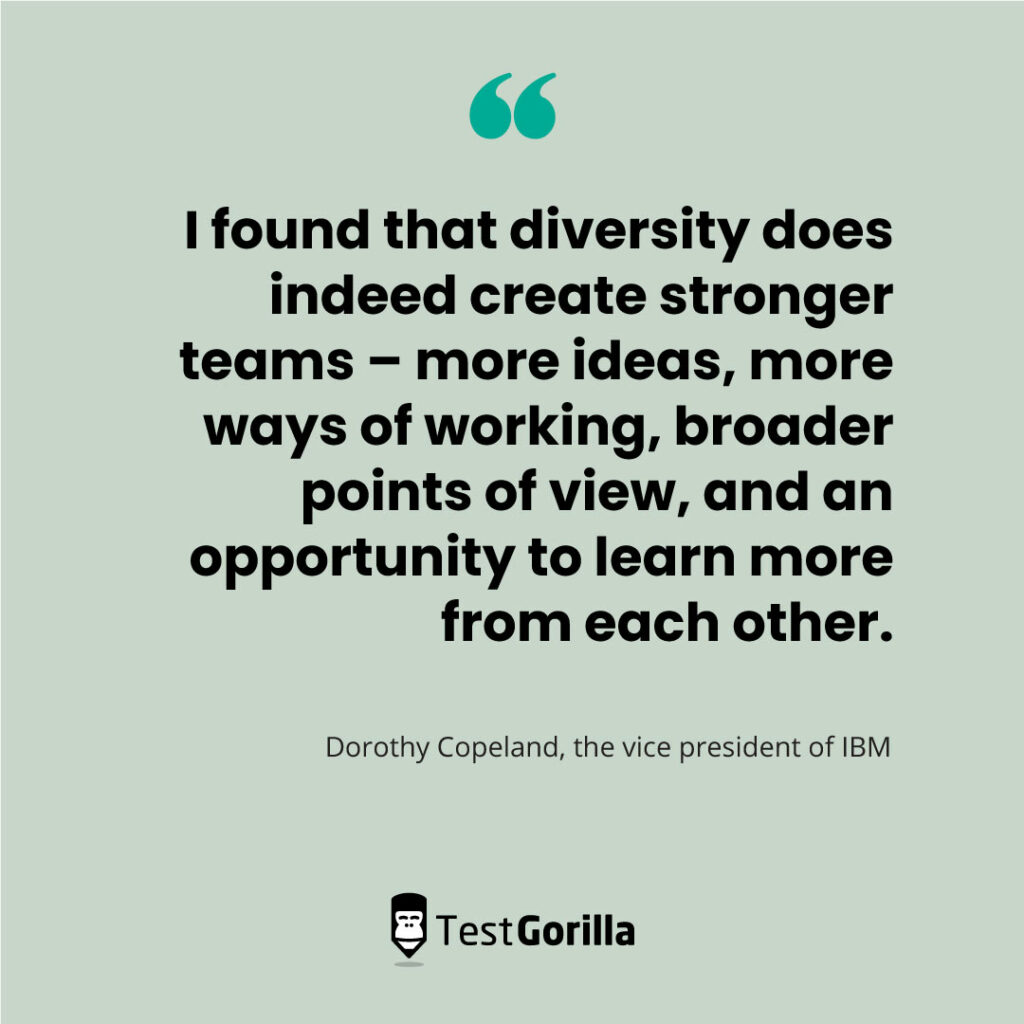A high-performing team is more than a collection of skilled employees.
Skilled people can excel at what they do but won’t necessarily work well together. A team is a group of people, so these people can’t just be outstanding on their own.
A high-performing team needs coordination, communication, and the ability to complement each other’s skill sets and working styles.
When great talent comes together they inspire those around them and achieve amazing business results for their companies. The question is, how to build a high-performing team?
This article explores the fundamentals of a high-performing team, how skills-based hiring can help you build one, and why diversity is such a crucial element.
Table of contents
What makes a high-performing team?
A high-performing team is a group of skilled individuals who work toward a common goal and excel at what they do. These teams produce consistently excellent results and are valuable assets in any organization.
Individual success is great in a company but, while still highly sought-after, can’t compete with a high-performing team.
Teams like these are more than a handful of talented people. Putting together individuals with diverse skills isn’t enough to build a high-performing team.
This means what you see on paper for each employee won’t translate perfectly to their ability to collaborate effectively.
Let’s use a famous example of a high-performing team: the 1992 Men’s Olympic Basketball Team, also known as the “Dream Team.”
This team was comprised of basketball legends such as Michael Jordan, Magic Johnson, and Larry Bird – they were all individually amazing players, but does that translate to a great team?
The very first game the Dream Team played was against a small college team. To their surprise, the superstars were obliterated. The score was so embarrassing that the coach removed the scoreboard before the media showed up.
How did this happen to a group of such talented people?
Because, at the time of the game, these players were simply a collection of individuals, not a team. They didn’t know how to work together.
Scottie Pippen, a member of the Dream Team, said it best: “We didn’t know how to play with each other.” [1]
But something magical happened after this group continued practicing together. They gradually learned how each other operated and began to complement each other’s skills. By the time the Olympics rolled around, the Dream Team was finally true to its name.
The Dream Team grabbed a gold medal in the 1992 Olympics, winning its eight games with an average of 43.8 points a game.
A single employee’s success should be celebrated, but the sky’s the limit when you have a high-performing team in your organization.
The 8 common characteristics of a high-performing team
It isn’t enough to say that high-performing teams are successful and desirable.
What factors constitute a high-performing team? How do you know when you have a true dream team in your company?
Let’s look at the eight most common characteristics of a high-performing team.
Clear expectations and a common goal
Commitment and motivation
A supportive environment
Diversity and a range of perspectives
Clear communication
An attitude toward continuous improvement
Collaboration and working well together
Outstanding leadership
Clear expectations and a common goal
Having specific objectives and defined expectations enables teams to focus their efforts on a shared goal.
These transparent goals should be on both an individual and a team level. The group has clear objectives, but all sub-objectives for each team member are also defined.
Teams with ambiguous or vague objectives can encounter any number of issues, such as running into last-minute disagreements or duplicating tasks. Clear objectives enable them to know what they’re after so they can attain it more successfully and precisely.
These goals should align with the company’s overall vision. In structured organizations, departmentalization helps define these objectives more clearly by grouping teams based on their functions or focus areas. This ensures that each department's goals contribute to the broader company mission.
This enables teams to better execute their objectives and brings them closer to the organization and its culture.
Commitment and motivation
High-performing teams show a powerful motivation to get the work done. They’re driven, willing, and committed to their goals.
This means high-performing teams are strongly committed to seeing projects through, take responsibility for their role, and strive to achieve the best possible outcomes.
A supportive environment
When it’s a dog-eat-dog world, nobody wins.
A high-performing team is fueled by mutual respect and recognition among team members. They realize that true success comes from collaboration and a strong respect for each other’s contributions.
This means celebrating each other’s wins and helping each other overcome failure.
Diversity and a range of perspectives
A good team can’t be the same person copy-and-pasted a dozen times. Diversity makes a team thrive and succeed.
A diverse range of perspectives, backgrounds, and opinions increases team creativity, opening their minds to new ideas and improving their problem-solving skills.
We aren’t just guessing, either. The benefits of diversity are both incredible and data-backed.
Clear communication
Open communication upgrades a good team to a great team.
It comes in a lot of flavors, such as constructive feedback and being open to new solutions.
Being on the same page with even the smallest statements is necessary for a good team. This includes clarifying statements like, “This needs to be done by tomorrow,” or “Heads up, I finished my sprint early if you want to get started.”
It enables a team to work efficiently, which means deadlines are met and workflow is smooth.
An attitude toward continuous improvement
Continuous improvement means the team is never “done” getting better.
This can include seeking learning and development opportunities and being open to feedback.
When all members of the team seek consistent learning and improvement, the team continuously upgrades and becomes the best version of itself.
Collaboration and working well together
When teammates understand how others work, they all work better together.
Like the Dream Team, you need to pay extra attention to how each other works and how best you can complement them.
A great example is the Rolling Stones. Even after 50 years, they still devote two months to group practice before every tour. They say they now have a near-telepathic bond that enables them to play together so well.[2]
With enough practice, any team can synchronize in impressive ways.
Outstanding leadership
A team can’t be high-performing without a great leader. Great leadership drives a team forward and inspires better performance.
What makes a great leader?
Skills like conflict resolution, motivation, task delegation, and communication can make a good leader into an outstanding leader.
For more on this topic, read our blog post on leadership skills in the workplace.
The best insights on HR and recruitment, delivered to your inbox.
Biweekly updates. No spam. Unsubscribe any time.
The benefits a high-performing team brings to your organization
A great team pays dividends to your organization in so many ways.
When a team collaborates well, supports each other, and targets its goals with precision, it can achieve amazing results.
Here are a few of the benefits a high-performing team brings to your company:
Higher trust, loyalty, and retention: Trust in the workplace is non-negotiable, and a high-performing team increases overall commitment and loyalty
Higher innovation and creativity: A team that supports itself opens the door for more creativity, encouraging innovation and growth
Increased engagement: High-performing teams are driven and motivated to achieve their goals, which means both their work and their colleagues engage them
Reduced burnout and quiet quitting: High-performing teams have a connection to their objectives and the organization, which reduces burnout and quiet quitting
Plus, high-performing teams are devoted to the best work outcomes, which means they achieve better business results.
High-performing teams produce higher-quality work, build better client relationships, and deliver consistent outputs.
The advantages of having a high-performing team in your organization are nearly countless. This means the only question left is…how do you build one?
How to build a high-performing team: 9 strategies
Summary
Use skills-based hiring to build the perfect team without bias.
Focus on diversity to nurture a dynamic team.
Foster a positive work environment and company culture.
Set clear goals, roles, and responsibilities.
Encourage open, honest communication that fosters trust.
Enable your team to maintain autonomy in their work.
Promote continuous improvement and learning.
Resolve conflict in nonviolent and healthy ways.
Become a high-performing leader.
Strategy | Description |
Use skills-based hiring to build the perfect team without bias | Hire team members based on their skills |
Reduce bias by dropping degree requirements | |
Focus on diversity to nurture a dynamic team | Diversify based on gender, ethnicity, and sexuality |
Boost innovation and productivity with added perspectives and diversity of thought | |
Foster a positive work environment and company culture | Create an environment where employees support and understand each other |
Focus more on “culture add” than “culture fit” | |
Set clear goals, roles, and responsibilities | Have team members know their goals to increase motivation |
Make sure everyone shares the same understanding of the project | |
Encourage open, honest communication that fosters trust | Create clear communication guidelines |
Promote a safe space for employees to openly talk | |
Enable your team to maintain autonomy in their work | Encourage independence and support unique strategies |
Resist the urge to micromanage | |
Promote continuous improvement and learning | Encourage team members to seek opportunities to learn |
Set goals that gradually increase to promote growth | |
Resolve conflict in nonviolent, healthy ways | Encourage healthy communication and conflict resolution |
Ensure issues don’t fester and promote openly discussing them | |
Lead from the top and be a high-performing leader | Practice these points yourself and lead your team by example |
1. Use skills-based hiring to build the perfect team without bias
Skills-based hiring is a hiring process that focuses on the talent and capability of a candidate with little reliance on work experience, education, and resumes.
According to The State of Skill-Based Hiring 2024, 81% of employers today use skills-based hiring to identify talent.
Focusing on candidate skills over certifications enables you to build a team based on capability, which means you can find team members who not only fulfill their role responsibilities but also complement one another.
Skills-based hiring is important because certifications and strict job requirements exclude millions of capable candidates.
Here’s a look at how many Americans don’t hold a four-year degree:
60% of American workers over the age of 25
It’s shocking how such a typical job requirement impacts diverse candidates.
Four-year degrees are not the only indicator of skill, so requiring them for a job role is an unnecessary barrier that denies you top talent and also denies candidates a chance at a great job.
There are more ways than a typical education for candidates to obtain key skills:
A candidate dropped out of college for financial reasons but otherwise excelled
A candidate gathered skills from working their way up from an unlikely job
A candidate obtained skills from a hobby, an interest, or volunteer work
However, more companies are making the shift from degrees to skills-based hiring.
Degree inflation, defined as the growing number of employers requiring degrees, has been getting worse since the 2000s. Although, from 2017 to 2020, the employer demand for degrees dropped by 46% for middle-skill positions and 31% for high-skill positions.
When you hire candidates through skills-based hiring, they also come with more unique skills and backgrounds not found in traditional hires.
Loren I. Shuster, the chief people officer of the LEGO Company, had quite an unconventional path to his current role, including being a commercial officer and having a background in business strategy.
Loren says that this unique background has given him a special perspective on his role and key skills others may not have.
This ties skill-based hiring directly to diversity. Let’s talk about that next.
🔍Need to hire a chief people officer for your own company? Here's our free chief people officer job description template to help you get started.
2. Focus on diversity to nurture a dynamic team
Diversity builds a strong, dynamic team.
A diverse range of skills, thoughts, perspectives, and backgrounds leads to a high-performing team that excels in innovation, creativity, and productivity.
There’s a direct link between diversity and high-performing teams:
Diverse teams are more creative and innovative
Gender-diverse companies are outperform their less diverse peers by an average of 1.2% annually.
Ethnically diverse companies are 36% more likely to financially outperform less diverse companies
TestGorilla’s State of Skills-Based Hiring report shows that diversity is a key objective for thousands of companies, and skills-based hiring is the way to achieve it.
We found that 85% of businesses in 2024 had a company goal of increasing diversity, and 90% of employers saw an increase in workplace diversity through skills-based hiring.
IBM is a great example of how skills-based hiring increases diversity – a metric that IBM takes incredibly seriously.
After reducing reliance on degrees and certifications for 50% of their roles, IBM has seen consistent increases in diverse and underrepresented talent, both across the company and in managerial roles.
Dorothy Copeland, the vice president of IBM, says their commitment to diversity creates amazing teams.
“I found that diversity does indeed create stronger teams – more ideas, more ways of working, broader points of view, and an opportunity to learn more from each other.”
Workplace diversity is non-negotiable for high-performing teams. A broad range of opinions and perspectives gives your team an edge that others simply can’t have.
3. Foster a positive work environment and company culture
A positive work environment makes all the difference in your organization, and it’s directly tied to company culture.
Company culture is one of the top job satisfaction factors, and it’s easy to see why. A thriving company culture that works well together and promotes a positive atmosphere is one of the most highly desired factors at work.
A 2022 study by MIT Sloan found that the biggest driver of turnover is a toxic corporate culture. This point ranked 10.4 times higher than compensation problems.
So how do you nurture a great organizational culture?
Prioritize culture add, not culture fit.
Culture fit, although used for decades now, has many issues associated with it. When you hire someone to fit directly into a culture, it can discriminate against gender, age, race, and orientation. For example, having a company culture that heavily focuses on masculine values is bound to narrow your perspective.
That’s why we promote culture add, which is the practice of finding a candidate with similar values to yours and incorporating them into your company. That way, your organization evolves with each new employee.
A positive organizational culture with diverse, culture-adding employees makes a team stronger and produces better outcomes.
For more information, read our blog post on culture add vs. culture fit.
4. Set clear goals, roles, and responsibilities
A high-performing team needs clear goals, roles, and responsibilities to maintain focus and put effort into a common goal.
In their book Leading Organizations: Ten Timeless Truths, Mary Meaney and Scott Keller explain that your team is 1.9 times more likely to have above-median financial performance if they’re working together toward a common vision.
Clear, shared goals streamline a team’s performance and enable them to produce consistent, excellent quality.
William Mendes, an engineer, speaks about his platform engineering team and how important clear goals were for them to become a truly high-performing team.
“[The] purpose served as a parameter to validate our goals and initiatives (through semi-annual OKRs), guide our efforts, and help prioritize the work we had to do.”
So how can HR help clarify goals and responsibilities?
One of the best ways is through hiring the right people. You can better align your people’s vision with your company’s vision by using culture assessments like our Culture Add test.
Hiring for culture creates a common ground of values and motivation for your team, ensuring members can work together smoothly to achieve the same goals.
You can also facilitate clear responsibilities by writing detailed, accurate job descriptions for each role.
5. Encourage open, honest communication that fosters trust
Encouraging communication is one of the simplest ways to set you up for success.
There are many great ways to promote team communication:
Make open dialogue a priority in your weekly standups
Encourage communication in meetings and in your group chat
Create communication guidelines (this can include when and how to update team software, like project management tools)
It’s more than just honesty, too. When a team knows they can communicate safely, they’re more likely to relax, share ideas, and perform better.
Google found this out in their famous Project Aristotle. After collecting massive amounts of data, they concluded that high-performing teams show sensitivity and listen to each other.[3]
The Project Aristotle researchers found that the key elements of a stellar team’s communications are:
Psychological safety
Dependability
Structure and clarity
Meaning
Impact
You can evaluate your team’s communication capabilities through our Communication test.
Whether it’s a brand-new candidate or you’re simply identifying internal skills gaps, this test enables you to assess the ability to communicate clearly and effectively.
6. Give your team autonomy in their work
Autonomy is a hot topic right now. Increasingly more workers demand it, and it’s easy to see why.
No one likes to be micromanaged.
When a team has strong autonomy, it not only boosts efficiency, it also increases trust, self-confidence, and performance.
Trust your employees, and they’ll trust you in return.
Here are a few tips to increase autonomy in your team:
Empower your team to make decisions
Resist the urge to micromanage and helicopter
Provide support and help only where needed
Give employees the tools they need
Encourage flexible policies, such as offering flexible work hours
Autonomy drives employee accountability and increases team relationships. When employees have independence, they feel like their contributions matter and that they have a stake in the company’s success.
7. Promote continuous improvement and learning
A belief in continuous learning and the drive to keep developing are essential. You never want your team to lose the drive to better their performance and processes.
Encouraging continuous improvement doesn’t just ensure your team keeps getting better in tangible skills-based ways. It’s more than that.
Promoting continuous improvement empowers your team’s mindsets and outlooks. It opens your team to new experiences, effective feedback, and unique ideas.
You can encourage continuous improvement in the usual ways, such as giving and receiving feedback, encouraging courses and lessons, and offering mentorship programs.
But you can also weave improvement into your team’s goals and objectives.
Try a gradual increase to goals each time one is accomplished, both individually and as a team. For example, a sales team had a goal to get 15% more leads this quarter. After comfortably succeeding, the next goal becomes 18% more leads.
8. Resolve conflict in nonviolent, healthy ways
Even when you consistently encourage a positive environment, you can’t avoid conflict 100% of the time, so the key is knowing how to handle it.
Disarming and dissolving conflict effectively helps build relationships and brings a team closer, which in turn increases their ability to work well together and complement each other’s skills.
We recommend practicing nonviolent communication to resolve conflict and make conversations healthier.
This involves two major elements that every participant must follow:
Clearly expressing themselves without assigning blame or criticism
Empathically listening to others without assuming blame or criticism
The ability to safely communicate through conflict helps build a strong, high-performing team.
A team at OfficeVibe found this out by implementing a rule they labeled “calling out the elephant.” This rule states that if a team member has an issue, they openly discuss and comb through the conflict before it stagnates or festers.
They say that performance has vastly improved since they implemented this rule. Courage and transparency became a necessity, and other teams in the office began using this rule, too.[4]
9. Lead from the top and be a high-performing leader
A high-performing leader is crucial to the creation of a high-performing team.
It’s often said that people learn from actions and not words, so leading by example and practicing what you preach is one of the best ways to instill the right characteristics in your team.
Every practice can be more effectively implemented when you lead by example. This process is natural – teammates learn by second nature.
This means a leader needs to adopt all these characteristics and actively display them.
Communicate well, resolve conflict, nurture a positive environment, and always seek improvement.
Build a diverse, high-performing team using skills-based hiring
You can see that a high-performing team is much more than a handful of skilled people.
These teams are diverse, complement each other, support each other, and are always open to improvement. Because of this, high-performing teams achieve amazing results.
Skills-based hiring helps you build a diverse high-performing team and toss bias out the window.
Overreliance on resumes and work history narrows your talent pool and puts a limit on diversity.
If you’d like to read more about this topic, read our article on how to expand your talent pool.
Frequently asked questions
What is a high-performing team?
A high-performance team is a group of individuals with complementary talents and skills. They are well-aligned and share common objectives, which they are able to achieve through effective collaboration and constant innovation. As a result, these teams are able to achieve superior results compared to their counterparts.
According to data from Gallup, teams that rank in the top 20% for connectedness experience 41% less absenteeism, 59% less employee turnover, and a 66% increase in employee well-being. They are also 21% more profitable than their counterparts.
How do you build a high-performing team?
There are nine key elements to building a high-performance team:
Onboard team members according to their competencies not their qualifications or experience. A high-performance team should consist of team members with a wide range of complementary skills that can be applied effectively in different scenarios.
Embrace diversity across your team. Research shows companies in the highest percentile for gender and racial diversity outperform industry benchmarks.
Create a safe and supportive environment where team members can feel free to bounce ideas off of each other without worrying about being misunderstood. Look for individuals that can add to your team culture rather than just fitting in.
Clearly establish the team’s roles, objectives, and individual responsibilities. This will help alignment amongst the team and ensure clarity of communication between members.
Set up guidelines for how the team should communicate and when. Ideally communication should be open, honest, and constructive.
Don’t micromanage team members. Instead, provide them with the tools and support they need to make their own decisions. Allow them to execute their tasks according to the approach that works best for them.
Promote a culture of continuous improvement by giving your team the training and resources to up-skill. They’ll surprise you with their ability to reach and surpass targets.
Look to resolve team conflicts with healthy communication and mutual agreement.
As a leader, model the behavior you would like to see demonstrated by your team. High-performance starts from the top.
Sources
Frey, Titan. (March 16, 2022). “The Only Game The 1992 Dream Team Ever Lost: The Score Was Removed From The Scoreboard Before The Media Entered”. Fadeaway World. Retrieved February 7, 2023. https://fadeawayworld.net/nba/the-only-game-the-1992-dream-team-ever-lost-the-score-was-removed-from-the-scoreboard-before-the-media-entered
“Teamwork Lessons From Pixar, The British Red Cross And The Rolling Stones”. (June 17, 2013). Leadernomics. Retrieved February 7, 2023. https://www.leaderonomics.com/articles/leadership/teamwork-lessons-from-pixar-the-british-red-cross-and-the-rolling-stones
“Understand Team Effectiveness”. (2012). Re: Work With Google. Retrieved February 7, 2023. https://rework.withgoogle.com/print/guides/5721312655835136/
Robins, Alison. “From storming to high-performing: the meeting that saved our team”. (March 10, 2022). Retrieved February 7, 2022. https://officevibe.com/blog/secret-high-performing-team
You've scrolled this far
Why not try TestGorilla for free, and see what happens when you put skills first.


